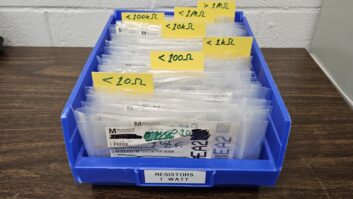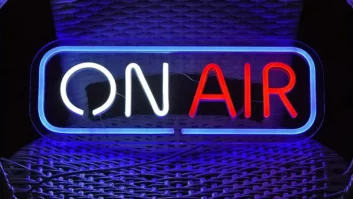(click thumbnail)Fig. 1: A Sharpie marker can be used for many things, although you don’t need one for an Audioarts D-16 Digital Console, as Jim Peck of SCMS cautions Jeffrey Rosenberg of Modulation Magic. Vermont Broadcast Associates Engineer Jamie Dennis looks on during the BOS-CON show in Marlborough, Mass. (The console sports an integrated router with channel source displays; no Dymo labeling needed.)Bob Sneeringer handles engineering with WBAL and WIYY in Baltimore. Bob writes with a complaint that many of us seasoned engineers have: failing eyesight. Bob says he has a tough time seeing the pin numbers on Molex or other connectors.
Bob has found, though, that by running a Sharpie permanent marker over the end of the connector makes the numbers pop right out. You can leave the end black, or remove the coloring with alcohol or lighter fluid. I’d prefer to leave the numbers colored, doing the next engineer a favor!
Bob is at [email protected].

. . .
Paul Kaminski of Motor Sports Radio and Radio World liked the advice regarding locks in the Sept. 24 Workbench. Paul adds that the TSA now is approving certain locks for luggage. The approval uses a “master key” approach, which means that an approved lock will have a “TSA” and a code number on it. This will permit the TSA operative to know which master key will open the locks.
While on the subject of locks, I’d like to throw out a question to our readers.
A tower owner is running into a problem of locks being cut by hunters and “four wheelers” – with the result that the gate at the tower entry point is left unlocked and open. Have you encountered this problem and found a lock system that deters trespassers?
With all of the recent site vandalism, site security should be top of mind. Share your successes (and what doesn’t work) by e-mailing your suggestions to me at [email protected].
Paul Kaminski can be reached at [email protected].
. . .
We’ve all got them, the hard carry cases that microphones come in. A typical station can have up to a dozen or so stuck in the back of the shop. They are too pretty to throw away, but in some instances are too small to be of any use.
Al Peterson at Radio America offers a great use for these boxes. He trims the foam blocks on the inside, and creates a grab-and-go reporter’s kit for his portable MiniDisc machines.
(click thumbnail)Fig. 2: This case had been used for an EV mic.
Fig. 2 shows a case formerly used for an Electro-Voice microphone. The blue block of plastic foam was trimmed from packing material that a computer was shipped in. The components were placed, traced, then removed; and the areas of foam were cut away to fit the components.
Inside the case is room for the MD recorder and media, a three-foot cable and matching transformer, a couple of batteries and an Audio-Technica microphone. Creating one of these kits takes minutes, saves your news department hours and helps to recycle both microphone cases and waste packing foam that might otherwise be discarded.
(click thumbnail)Fig. 3: All of the reporter’s tools are accommodated; the foam cutouts guard against any part being left behind.
Fig. 3 shows the finished product, with all components in place. In addition to having a case that holds all of the reporter’s tools, the foam cutouts guard against any part being left behind.
Don’t forget to include your business card or identify the case with your station’s calls and a phone number, with a note about a reward if returned. In case the kit is left behind, the identification may be useful, and some honest soul may actually call the number.


. . .
Greg Muir liked the reminders in the Sept. 24 issue, in which we discussed capacitors and ripple in power supplies. Greg has found that the easiest way to measure ripple is simply to use a digital multimeter on the AC range and apply it across the DC circuit you want to measure. If there’s an appreciable AC component, you’ll see it.
Most DMMs are DC-isolated in the AC mode. Use the range switch to scale the meter down to the millivolt range to measure a small AC component accurately. The measurement process is quick and accurate, and it sure beats lugging around a scope. With the prices dropping, hopefully everyone has a DMM in their toolbox.
(click thumbnail)Fig. 4: Wavetek’s DM16XL
A Wavetek DM16XL will measure down to a full scale range of 200mV. Greg writes that it is worth a quick test to see if the more inexpensive DMMs (<$20 or so) will accurately make this measurement before you have to rely on them to do so. Some may behave strangely. So the best advice is to lug out that ‘scope, and compare the readings to your DMM. Once you’ve verified that you can rely on the meter, measure away.
Greg adds another tip, useful for “future” troubleshooting. Take the DMM and make a large number of quick, non-invasive “good” circuit measurements. Note them on the equipment schematics. These “good” measurements will be useful for future reference when troubleshooting the equipment.
Using a DMM in this manner has an advantage over the tried-and-true analog VOM. Due to the full wave bridge meter rectifier used for AC measurements, used in the analog VOM, the DC component will also be passed.
Submissions for this column are encouraged, and qualify for SBE recertification credit.













